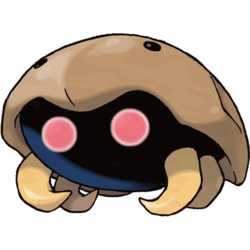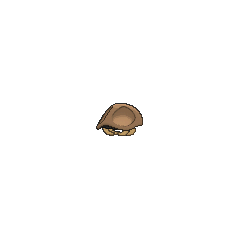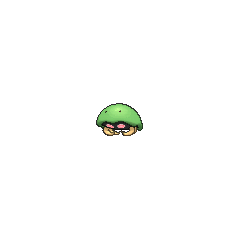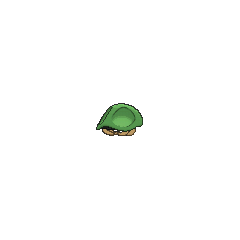From Bulbapedia, the community-driven Pokémon encyclopedia.
|
|
| Line 71: |
Line 71: |
| A Kabuto Fossil is seen in ''[[BW014|A Night in the Nacrene City Museum!]]'' as an exhibit in the [[Nacrene City]] Museum. | | A Kabuto Fossil is seen in ''[[BW014|A Night in the Nacrene City Museum!]]'' as an exhibit in the [[Nacrene City]] Museum. |
|
| |
|
| Two Kabuto appeared in ''[[XY086|The Tiny Caretaker!]]''. | | Two Kabuto appeared in ''[[XY087|The Tiny Caretaker!]]''. |
|
| |
|
| ===Pokédex entries=== | | ===Pokédex entries=== |
Revision as of 08:35, 11 May 2016
Kabuto (Japanese: カブト Kabuto) is a dual-type Rock/Water Fossil Pokémon.
It is resurrected from a Dome Fossil and evolves into Kabutops starting at level 40.
Biology
Kabuto is a small Pokémon with a large brown shell covering its body. There are two small eyes facing upwards on the outside of its shell, which it uses for sight when it hides on the ocean floor. The structure of its body is almost entirely unknown, except its four short, yellow legs and luminescent red eyes on its underside. Having been thought extinct as of roughly 300 million years ago, in modern days, most living Kabuto are resurrected from Dome Fossils.
Although Kabuto have been found fossilized by way of lying on the ocean floor for millennia, on rare occasions, it has been found still living. In its original time, it was prominently found on beaches, likely aided by its fast and powerful swimming ability. As seen in the anime, Kabuto prefer seclusion and can be very territorial.
In the anime
Major appearances
Kabuto was one of the Fossil Pokémon that attacked Ash and Team Rocket until being scared off by an Aerodactyl in Attack of the Prehistoric Pokémon.
In Shell Shock!, a "deranged old man" named Umberto was saying that an island full of Kabuto Fossils would sink once the moon casted a red glow. He was right, because the Fossils came to life and the island collapsed, since the Fossils kept the island together.
In Dealing With Defensive Types!, a Kabuto, along with an Omanyte and Omastar, attacked Team Rocket in the Canalave Gym.
Minor appearances
Bill was trapped in a Kabuto costume at the beginning of Mystery at the Lighthouse.
A Kabuto appeared in a fantasy in A Ruin with a View and Where's Armaldo?.
A Kabuto appeared in the opening of Lucario and the Mystery of Mew.
A Mirage Kabuto appeared in a flashback in The Mastermind of Mirage Pokémon.
A Kabuto appeared in Wild in the Streets!.
A Kabuto Fossil is seen in A Night in the Nacrene City Museum! as an exhibit in the Nacrene City Museum.
Two Kabuto appeared in The Tiny Caretaker!.
Pokédex entries
| Episode
|
Pokémon
|
Source
|
Entry
|
| EP046
|
Omanyte, Omastar, Kabuto, and Kabutops
|
Ash's Pokédex
|
Omanyte and Omastar, Kabuto and Kabutops. It is believed these Pokémon became extinct tens of thousands of years ago. The details of their behavior are shrouded in mystery. Though some have speculated that they may still exist, none of these Pokémon have ever been seen alive.
|
| Original series entries continue below.
|
|
| Episode
|
Pokémon
|
Source
|
Entry
|
| EP089
|
Kabuto
|
Ash's Pokédex
|
Kabuto, the Ancient Pokémon. Though this Pokémon is now to be extinct, it had a hard shell that protected its body and is believed to have been a powerful swimmer.
|
|
In the manga
In the Pokémon Adventures manga
Brock rescued the employees of the Pewter City Museum and got a Kabuto as thanks in Striking Golduck. It eventually evolved into a Kabutops prior to the Gold, Silver, & Crystal arc.
In the TCG
- Main article: Kabuto (TCG)
In the TFG
One Kabuto figure has been released.
Game data
Pokédex entries
| Generation I
|
|
| Red(ENG)
|
A Pokémon that was resurrected from a fossil found in what was once the ocean floor eons ago.
|
| Blue
|
| Yellow
|
A Pokémon that was recovered from a fossil. It uses the eyes on its back while hiding on the sea floor.
|
| Stadium
|
A Pokémon that was resurrected from a fossil found in an ancient seabed. Unable to right itself if it is flipped over.
|
|
|
| Generation II
|
|
| Gold
|
On rare occasions, some have been found as fossils which they became while hiding on the ocean floor.
|
| Silver
|
This Pokémon lived in ancient times. On rare occasions, it has been discovered as a living fossil.
|
| Crystal
|
Three hundred million years ago, it hid on the sea floor. It also has eyes on its back that glow.
|
| Stadium 2
|
On rare occasions, some have been found as fossils which they became while hiding on the ocean floor.
|
|
|
| Generation III
|
|
| Ruby
|
Kabuto is a Pokémon that has been regenerated from a fossil. However, in extremely rare cases, living examples have been discovered. The Pokémon has not changed at all for 300 million years.
|
| Sapphire
|
| Emerald
|
It is a Pokémon that has been regenerated from a fossil. However, in rare cases, living examples have been discovered. Kabuto have not changed for 300 million years.
|
| FireRed
|
This Pokémon was regenerated from the fossil of an ancient creature. It protects itself with a hard shell.
|
| LeafGreen
|
A Pokémon that was regenerated from a fossil found in what was once the ocean floor long ago.
|
|
|
| Generation IV
|
|
| Diamond
|
It is thought to have inhabited beaches 300 million years ago. It is protected by a stiff shell.
|
| Pearl
|
| Platinum
|
| HeartGold
|
On rare occasions, some have been found as fossils which they became while hiding on the ocean floor.
|
| SoulSilver
|
This Pokémon lived in ancient times. On rare occasions, it has been discovered as a living fossil.
|
|
|
| Generation V
|
|
| Black
|
It is thought to have inhabited beaches 300 million years ago. It is protected by a stiff shell.
|
| White
|
| Black 2
|
It is thought to have inhabited beaches 300 million years ago. It is protected by a stiff shell.
|
| White 2
|
|
|
| Generation VI
|
|
| X
|
It is thought to have inhabited beaches 300 million years ago. It is protected by a stiff shell.
|
| Y
|
This Pokémon was regenerated from the fossil of an ancient creature. It protects itself with a hard shell.
|
| Omega Ruby
|
Kabuto is a Pokémon that has been regenerated from a fossil. However, in extremely rare cases, living examples have been discovered. The Pokémon has not changed at all for 300 million years.
|
| Alpha Sapphire
|
|
|
Game locations
In side games
|
|
| Generation II
|
|
| This Pokémon is unavailable in Generation II side games.
|
|
|
|
|
|
|
|
|
|
|
In events
In-game events
Held items
Stats
Base stats
| Stat
|
Range
|
| At Lv. 50
|
At Lv. 100
|
30
|
|
90 - 137
|
170 - 264
|
80
|
|
76 - 145
|
148 - 284
|
90
|
|
85 - 156
|
166 - 306
|
55
|
|
54 - 117
|
103 - 229
|
45
|
|
45 - 106
|
85 - 207
|
55
|
|
54 - 117
|
103 - 229
|
Total: 355
|
Other Pokémon with this total
|
- Minimum stats are calculated with 0 EVs, IVs of 0, and (if applicable) a hindering nature.
- Maximum stats are calculated with 252 EVs, IVs of 31, and (if applicable) a helpful nature.
- This Pokémon's Special base stat in Generation I was 45.
|
Pokéathlon stats
Type effectiveness
| Under normal battle conditions in Generation IX, this Pokémon is:
|
|
|
|
|
|
|
|
|
|
|
|
|
Learnset
|
|
|
|
- Bold indicates a move that gets STAB when used by Kabuto
- Italic indicates a move that gets STAB only when used by an Evolution of Kabuto
- Click on the generation numbers at the top to see level-up moves from other generations
|
|
|
|
|
- Bold indicates a move that gets STAB when used by Kabuto
- Italic indicates a move that gets STAB only when used by an Evolution of Kabuto
- Click on the generation numbers at the top to see TM moves from other generations
|
|
|
|
|
- Moves marked with an asterisk (*) must be chain bred onto Kabuto in Generation VI
- Moves marked with a double dagger (‡) can only be bred from a Pokémon who learned the move in an earlier generation.
- Moves marked with a superscript game abbreviation can only be bred onto Kabuto in that game.
- Bold indicates a move that gets STAB when used by Kabuto
- Italic indicates a move that gets STAB only when used by an Evolution of Kabuto
- Click on the generation numbers at the top to see Egg moves from other generations
|
|
|
|
|
- A black or white abbreviation in a colored box indicates that Kabuto can be tutored the move in that game
- A colored abbreviation in a white box indicates that Kabuto cannot be tutored the move in that game
- Bold indicates a move that gets STAB when used by Kabuto
- Italic indicates a move that gets STAB only when used by an Evolution of Kabuto
- Click on the generation numbers at the top to see Move Tutor moves from other generations
|
Side game data
Evolution
Sprites
Trivia
Origin
Kabuto's design consists of a mix of trilobite and the still-living (but considered a living fossil) horseshoe crab.
Name origin
Kabuto is derived from 兜蟹 kabutogani (horseshoe crab). 兜 Kabuto is also the Japanese word for helmet, specifically the traditional helmets samurai wear.
In other languages
| Language
|
Title
|
Meaning
|
 Japanese Japanese
|
カブト Kabuto
|
From 兜蟹 kabutogani
|
 French French
|
Kabuto
|
Same as English/Japanese name
|
 Spanish Spanish
|
Kabuto
|
Same as English/Japanese name
|
 German German
|
Kabuto
|
Same as English/Japanese name
|
 Italian Italian
|
Kabuto
|
Same as English/Japanese name
|
 Korean Korean
|
투구 Toogu
|
A shortening of 투구게 tuguge. Note that 투구 tugu means "helmet."
|
 Mandarin Chinese Mandarin Chinese
|
化石盔 Huàshíkuī
|
Literally "Fossil helmet"
|
 Cantonese Chinese Cantonese Chinese
|
萬年蟲 Maahnnìhnchùhng
|
Literally "Ten-thousand year bug"
|
|
|
|
| More languages
|
 Hindi Hindi
|
काबूतो Kabuto
|
Same as English name
|
|
|
|
Notes
External links

|
This Pokémon article is part of Project Pokédex, a Bulbapedia project that aims to write comprehensive articles on each Pokémon species, as well as Pokémon groups and forms.
|
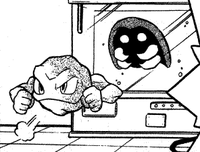
 For other sprites and images, please see Kabuto images on the Bulbagarden Archives.
For other sprites and images, please see Kabuto images on the Bulbagarden Archives.


